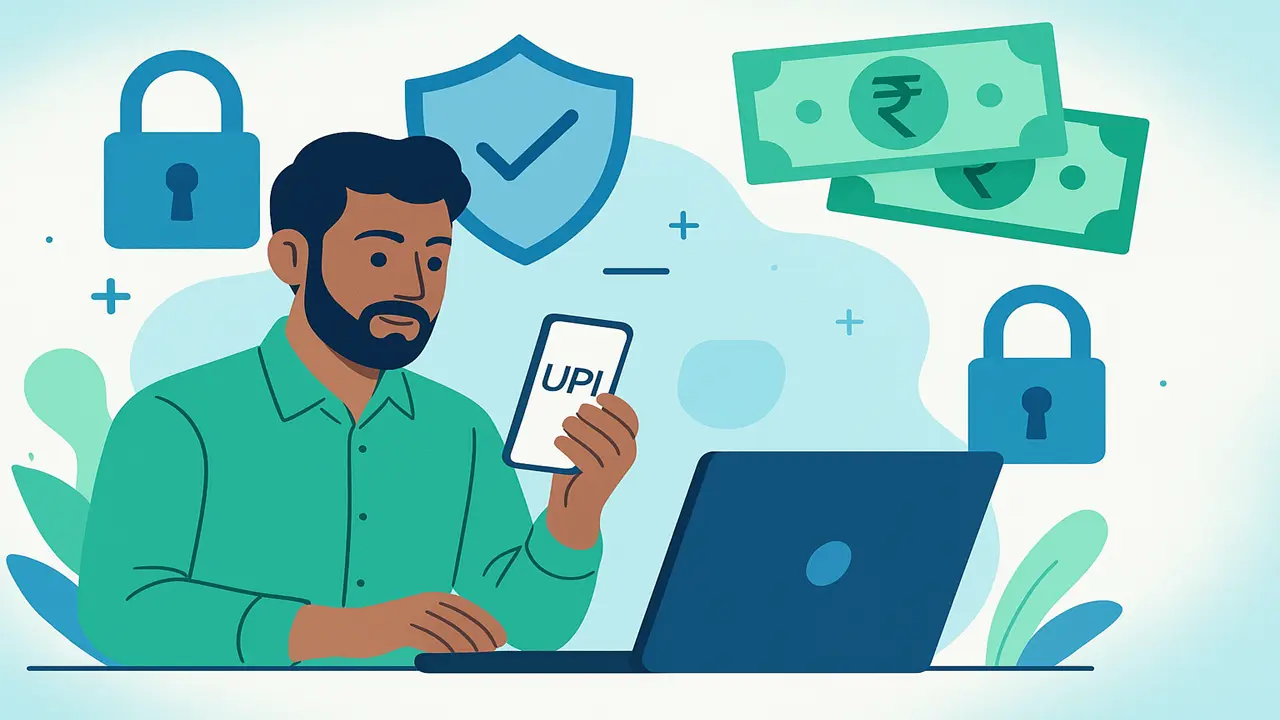Digital payments have transformed how Indians handle money, with UPI and net banking leading the charge. As UPI processes over 650 million transactions daily and net banking offers comprehensive financial control, safety remains a top concern for users across urban and rural areas. Choosing between UPI’s convenience and net banking’s versatility requires understanding their security features. This guide compares UPI vs. net banking to determine what’s safer in 2025, empowering you to transact confidently.
What is UPI?
Unified Payments Interface (UPI), launched by NPCI in 2016, is a real-time payment system linking multiple bank accounts to a single mobile app. It enables instant transfers using a Virtual Payment Address (VPA), like name@bank, or QR codes. UPI is popular for small transactions, like ₹50 chai payments or ₹5,000 bill settlements. Apps like PhonePe and Google Pay make it accessible for all Indians.
Business Loan
Get personal loan up to 5 CR
Home Loan
Get home loan up to 50 lakhs
UPI requires a UPI PIN for authentication, ensuring secure transactions. It supports peer-to-peer and merchant payments without sharing bank details. Its simplicity suits daily use across diverse incomes. UPI’s widespread adoption reflects its convenience and efficiency.
What is Net Banking?
Net banking, or internet banking, allows users to manage finances through a bank’s online portal or app using a user ID and password. It offers services like fund transfers (NEFT, RTGS, IMPS), bill payments, and account management. In India, banks like SBI and HDFC provide robust net banking platforms. It’s ideal for comprehensive banking needs.
Net banking requires two-factor authentication, often via OTP or biometrics, for secure access. It involves entering beneficiary details, like account numbers and IFSC codes, for transfers. Its versatility suits large transactions or loan applications. Net banking remains a trusted option for detailed financial tasks.
Why Safety Matters in Digital Payments
Digital transactions in India face risks like phishing, fraud, and data breaches, making security critical. In 2024, UPI frauds cost ₹2,200 crore, highlighting vulnerabilities despite robust systems (Moneycontrol). Safe payment methods protect savings, especially for small earners or rural users. Understanding security features helps avoid financial losses.
Both UPI and net banking incorporate advanced encryption and authentication to safeguard users. However, their safety depends on user practices and platform design. Comparing their security measures clarifies which is safer for your needs. Informed choices minimize risks in India’s digital economy.
UPI Security Features

Aadhar Pe Loan
Get aadhar loan up to 1 lakhs
Personal Loan
Get personal loan up to 5 lakhs
UPI uses two-factor authentication, requiring a UPI PIN alongside a registered mobile number for transactions. This ensures only authorized users can transact, even if a phone is compromised. Transactions are encrypted, protecting data during transfers. No bank details are shared, reducing fraud risks.
UPI apps allow instant fraud reporting, enabling quick account freezing. NPCI’s guidelines mandate biometric options like fingerprints for added security. Users receive real-time SMS or app notifications for every transaction. These features make UPI highly secure for daily use.
Net Banking Security Features
Net banking employs two-factor authentication, typically an OTP sent via SMS or email, alongside a password. Banks like HDFC use device authentication to verify trusted devices, adding an extra layer of protection. Transactions are secured with 128-bit SSL encryption, ensuring data safety. Beneficiary details must be verified before transfers, reducing errors.
Net banking portals allow users to set transaction limits, like ₹50,000 daily, to control risks. Banks invest in anti-fraud systems to monitor suspicious activities. Users can lock accounts instantly via bank apps if fraud is suspected. These measures ensure robust security for complex transactions.
Comparing UPI and Net Banking Safety
Both UPI and net banking are secure, but their safety varies by use case and user behavior. UPI’s simplicity minimizes input errors, as only a VPA or QR code is needed. Net banking’s detailed process, requiring account numbers and IFSC codes, may increase manual errors but adds verification layers. UPI’s real-time processing suits quick payments, while net banking’s batch processing (e.g., NEFT) delays large transfers, reducing immediate fraud risks.
UPI’s mobile-first design makes it vulnerable to smartphone theft or phishing apps, unlike net banking’s broader access via laptops. However, net banking requires strong passwords, which users often reuse, risking breaches. Both systems use encryption and authentication, but UPI’s lack of anonymity (linked to bank accounts) may concern privacy-focused users. Ultimately, safety hinges on user vigilance.
UPI Risks and How to Mitigate Them
UPI frauds often stem from phishing scams, where users share PINs via fake apps or messages. For example, a ₹10,000 loss may occur if a user enters their PIN on a fraudulent QR code. Technical glitches, like server downtime, can delay transactions, causing confusion. Smartphone dependency excludes users without reliable devices.
To stay safe, use trusted apps like BHIM or Paytm from official stores. Never share your UPI PIN, even with bank officials. Verify recipient VPAs before transferring funds, like checking name@bank. Enable biometric authentication and avoid public Wi-Fi for transactions.
Net Banking Risks and How to Mitigate Them
Net banking faces risks from phishing emails or fake bank websites stealing login credentials. A ₹50,000 unauthorized transfer could occur if a user logs into a fraudulent portal. Weak passwords or reused credentials increase vulnerability. Poor internet connectivity may cause transaction failures.
Use strong, unique passwords and enable two-factor authentication for net banking. Access portals only via official bank websites, like sbi.co.in, and avoid clicking email links. Install antivirus software on devices to block malware. Log out after each session to prevent unauthorized access.
Which is Safer for Small Transactions?
For small transactions, like ₹100 grocery payments, UPI is generally safer due to its simplicity and speed. Its minimal input requirements reduce errors, and the UPI PIN ensures secure authentication. Real-time notifications alert users to unauthorized ₹50 spends instantly. UPI’s QR code payments are ideal for daily use in India’s cashless economy.
Net banking is less practical for small, frequent transactions due to its detailed process. Entering beneficiary details for a ₹200 payment is cumbersome compared to UPI’s VPA. However, net banking’s transaction limits offer control for cautious users. UPI’s ease makes it safer for quick, low-value transfers.
Which is Safer for Large Transactions?
For large transactions, like ₹5 lakh home payments, net banking is often safer due to its structured process. Adding and verifying beneficiaries before transfers reduces fraud risks. Banks’ anti-fraud monitoring systems flag suspicious high-value activities. Transaction delays via NEFT provide a buffer to detect errors.
UPI’s ₹1 lakh daily limit (₹2 lakh for specific categories) restricts large transfers, requiring multiple transactions, which increases exposure. Its instant processing leaves less time to reverse errors. Net banking’s robustness suits significant financial tasks. Choose net banking for high-value security.
User Practices for Safe Transactions
Safety depends heavily on user habits for both UPI and net banking. Regularly monitor transaction history via apps like Google Pay or SBI YONO to spot ₹500 unauthorized spends. Update apps from official stores to patch security vulnerabilities. Avoid sharing OTPs, PINs, or passwords with anyone, including bank staff.
Use secure networks, not public Wi-Fi, for transactions to prevent data theft. Enable multi-factor authentication, like biometrics, on UPI apps and net banking portals. Report fraud immediately via bank helplines or NPCI’s UPI complaint portal. Vigilant practices enhance safety for both methods.
Common Mistakes to Avoid
Don’t reuse passwords across UPI apps and net banking portals, as a breach in one compromises both. For example, a hacked ₹1,000 UPI transaction could lead to net banking losses. Avoid clicking unverified links promising cashback, like ₹500 rewards, which steal credentials. These errors expose users to fraud.
Don’t ignore transaction alerts, as unnoticed ₹2,000 spends signal breaches. Avoid saving bank details on shared devices, risking unauthorized ₹10,000 transfers. Regularly change UPI PINs and net banking passwords for added security. Avoiding these mistakes ensures safer digital payments.
Tools to Enhance Digital Payment Safety
Technology bolsters UPI and net banking security. Apps like Paytm offer security shields requiring passcodes or biometrics to access. Bank apps like HDFC NetBanking allow transaction limit settings to cap risks. NPCI’s BHIM app supports direct complaint filing for UPI issues.
Antivirus software on smartphones and laptops protects against malware targeting UPI or net banking. RBI’s guidelines mandate banks to use encryption and fraud monitoring. Use official apps from Google Play or bank websites for secure transactions. These tools safeguard your finances.
Conclusion
Both UPI and net banking are safe for digital payments in India when used wisely. UPI excels for small, quick transactions with its simple, PIN-based authentication, while net banking’s structured process suits large transfers. Prioritize trusted apps, strong passwords, and vigilant monitoring to minimize risks. Choose the safer option in 2025 based on your transaction needs and stay secure in India’s digital economy.
FAQs
1. Is UPI safer than net banking?
UPI is safer for small transactions due to its simple VPA and PIN authentication, while net banking suits large transfers with added verification layers.
2. What makes UPI secure?
UPI uses two-factor authentication (PIN and mobile number), encryption, and real-time alerts, minimizing fraud risks without sharing bank details.
3. How can I protect my net banking account?
Use strong passwords, two-factor authentication, official bank websites, and antivirus software, and avoid public Wi-Fi or unverified links.
4. What are common UPI fraud risks?
Phishing scams, fake QR codes, and PIN sharing pose risks, but using trusted apps and verifying recipients prevent fraud.
5. Which is better for daily payments in India?
UPI is better for daily payments, like ₹100 groceries, due to its speed, QR code support, and integration with apps like PhonePe.
